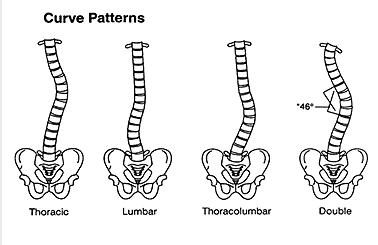
types of scoliosis
Scoliosis is described as a lateral deviation of the spine. From the back, your spine should look straight. When the vertebrae begin to tilt and move off to the side at some point they must come back to center. Many times there are actually 2 different lateral curves (an S curve), the first to one side, and a second to the opposite side. There can also be rotation of the individual vertebrae further complicating the scoliosis.
Scoliosis is rated by the degree of the curvature. The higher the degree, the more pronounced the scoliosis. Most scoliosis progress at a slow degree; however, there are some that progress fast – especially during growth spurts. Scoliosis tends to affect more girls/women than men, and many are genetically based. I have seen granddaughters, mothers, and grandmothers all with the same scoliosis – just at different degrees. Without treatment, the scoliosis will become more pronounced with age. By the same token, the earlier you treat a scoliosis the less impact the scoliosis will have on your life.
When should you start looking for scoliosis signs?
Scoliosis really starts to show up in the pre-teens, because as a growth spurt starts the inequities in the spine begin to show up. A simple visual test of having the child bend over at the waist and inspecting their back to make sure it is straight is a good beginning. Look for shoulders being unleveled, hips at different heights, one shoulder blade winging, and their head not over their pelvis. If your child is beginning to complain of back pain, they should be evaluated by a chiropractor for scoliosis. If there is a family history of scoliosis, your children should all be checked by a chiropractor when they are pre-teens or even earlier.
How do you treat scoliosis?
Chiropractors will evaluate the scoliosis and the progression of the scoliosis. This may be done visually and with some simple orthopedic tests, and it may include x-rays. For young children, x-rays may not be recommended if the scoliosis appears to be mild and responds to treatment. Chiropractic treatment consists of gentle adjustments (moving the vertebrae) and then specific individual exercises to help strengthen the person’s muscles to help keep the vertebrae in place.
What if scoliosis is left untreated?
Most scoliosis is of mild to moderate degrees and if it is left untreated will slowly progress further. Common symptoms from scoliosis include: back pain, muscle spasms, leg pain, neck pain, and headaches. If there is a lot of twisting in the scoliosis, then some internal organs can be compressed or compromised. For severe or quickly progressing scoliosis after conservative chiropractic treatment has been tried, then a referral to an orthopedist who specializes in scoliosis may be needed. For young adolescents who have not reach growth maturity, bracing is one option. For adults some surgeries may be appropriate if there is internal organ compromise.

Chiropractic treatment is one of the best methods for treating numerous health problems naturally. After years of experience being a chiropractor, I have found that it is a powerful way to solve many non-pain condition as well, such as fatigue, sleep problems, and sinus problems.